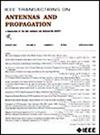Planar Surface-Wave Antenna for CubeSats With Directive Radiation Exactly at Endfire
IF 5.8
1区 计算机科学
Q1 ENGINEERING, ELECTRICAL & ELECTRONIC
引用次数: 0
Abstract
A two-layer planar surface-wave antenna (SWA) with directive gain exactly at endfire is proposed for applications including integration with solar panels, CubeSats, and other small satellites. Moreover, by co-design and including air vias (AVs) for the surface-wave aperture, the structure becomes semi-transparent and can be positioned on top of solar panels, and this can improve solar power harvesting capabilities. Structure excitation is made possible by a leaky T-junction dual-feeder using substrate-integrated waveguide (SIW) technology, creating a uniform wavefront that propagates through a truncated parallel-plate waveguide (PPW) section. In addition, a matching section based on an array of subwavelength printed patches is also included at the interface between the PPW and the grounded dielectric slab (GDS), while the AV section is positioned between the GDS and air region to improve antenna radiation. These features allow for an efficient and compact aperture, and findings are competitive compared to other relevant structures. For instance, the measured prototype demonstrated a peak realized gain (RG) of 17.5 dBi at 18.6 GHz, as well as high radiation efficiency and sidelobe levels (SSLs) of about −10 dB. This makes the SWA suitable for high data rate downlink communications when nondeployable designs are required on CubeSats, for example, or wherever a low-profile, simple, and planar antenna is needed with radiation directly at endfire.端火精确定向辐射立方体卫星平面表面波天线
针对太阳能板、立方体卫星和其他小型卫星的集成应用,提出了一种具有精确端面增益的两层平面表面波天线(SWA)。此外,通过共同设计和包括空气孔(AVs)的表面波孔径,结构变得半透明,可以定位在太阳能电池板的顶部,这可以提高太阳能收集能力。采用衬底集成波导(SIW)技术的漏t结双馈线可以实现结构激励,从而产生均匀的波前,通过截断的平行板波导(PPW)部分传播。此外,在PPW和接地介质板(GDS)之间的接口处还包括基于亚波长印刷贴片阵列的匹配部分,而AV部分位于GDS和空气区域之间,以提高天线的辐射。这些特点允许一个高效和紧凑的光圈,与其他相关结构相比,研究结果具有竞争力。例如,测量的原型在18.6 GHz时显示出17.5 dBi的峰值实现增益(RG),以及约−10 dB的高辐射效率和副瓣电平(SSLs)。这使得SWA适用于高数据速率下行通信,例如,当需要在立方体卫星上进行不可部署设计时,或者需要在端火直接辐射的低轮廓、简单平面天线时。
本文章由计算机程序翻译,如有差异,请以英文原文为准。
求助全文
约1分钟内获得全文
求助全文
来源期刊
CiteScore
10.40
自引率
28.10%
发文量
968
审稿时长
4.7 months
期刊介绍:
IEEE Transactions on Antennas and Propagation includes theoretical and experimental advances in antennas, including design and development, and in the propagation of electromagnetic waves, including scattering, diffraction, and interaction with continuous media; and applications pertaining to antennas and propagation, such as remote sensing, applied optics, and millimeter and submillimeter wave techniques

 求助内容:
求助内容: 应助结果提醒方式:
应助结果提醒方式:


